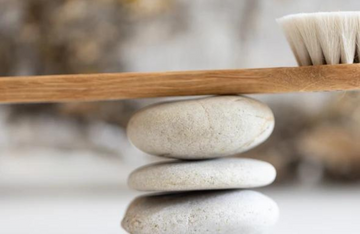Dry brushing is a practice known for its many benefits. It was first practiced over 5,000 years ago in India as a type of Ayurveda medicine. Chinese, Greek, and Roman civilizations also used it to treat multiple health conditions. As beneficial as it is for the body, it is equally as beneficial for the face and neck. However, it can be more preferable to use a soft bristle dry brush for these areas depending on individual skin sensitivity.
If you want to make this a regular practice and experience dry brushing benefits, you could stack the habit onto your shower routine to act as the cue for the practice to take place.

1. Dry brushing benefits for your Face and Neck
Dry brushing your face and neck has numerous advantages, including improved skin health and well-being. Here's a rundown of dry brushing benefits, backed up by historical research:
Exfoliation of the Skin:
-
Dry brushing has roots in ancient cultures such as Ayurveda, when it was used to rejuvenate and exfoliate the skin.
-
Gently exfoliating the skin removes dead skin cells, unclogs pores, and stimulates cell turnover, resulting in a smoother complexion.
Enhanced Blood Circulation:
-
Dry brushing is consistent with Traditional Chinese Medicine's emphasis on promoting blood flow for health.
- Dry brushing increases blood circulation to the skin's surface, supplying nutrients and oxygen, and may help for a healthier and more luminous complexion.
Drainage of the Lymphatic System:
-
The importance of lymphatic health was acknowledged in ancient Greek and Roman societies.
-
Dry brushing is thought to stimulate the lymphatic system, assisting in the drainage of toxins and debris. Improved lymphatic drainage may contribute to less puffiness and a brighter complexion.
Reducing Stress:
-
Dry brushing has been used in many cultures as part of relaxing and self-care rituals.
-
Dry brushing can be a relaxing and contemplative exercise, potentially reducing stress and boosting overall well-being.
2. How Often Should you Dry Brush your Face and Neck?
The frequency of dry brushing your face and neck is determined by your own preferences, skin type, and unique skincare requirements. For best results, experts recommend including dry brushing into your skincare routine two to three times each week. However, it's critical to monitor your skin's reaction and modify the frequency as needed. Those with more sensitive skin may benefit from a milder approach, such as restricting dry brushing to once a week into your skin care routine. Individuals with oily or thicker skin, on the other hand, may discover that they may comfortably incorporate it more frequently.
3. Can you use any Type of Brush for Dry Brushing your Face and Neck?
There are many types of dry brushes, however choosing the proper brush for dry brushing your face and neck is crucial for a pleasant and successful experience. Select a brush that is specifically developed for sensitive facial skin, with soft bristles and high-quality materials. Choose a brush with natural bristles, which are gentler and less abrasive, especially for sensitive skin. Look for a brush with a comfortable handle that allows you to maintain a strong grip while brushing. The best brushes for dry brushing include fan-shaped or oval heads, which allow for easy movement over the contours of the face and neck.
4. Should you Moisturize after Dry Brushing your Face and Neck?
Moisturizing your face and neck after dry brushing is an important step in maximizing the advantages of this skincare routine. Dry brushing exfoliates the skin by eliminating dead cells, making it more responsive to moisture. Choose a moisturizer or cream that is appropriate for your skin type; for example, a lightweight, vegan moisturizer is great for oily or acne-prone skin, whilst heavier formulations may benefit dry skin.
5. How Many Times a Week should I Dry Brush my Face?
For most skin types, experts recommend including face dry brushing into your skincare routine 2 to 3 times per week. This frequency promotes a healthy complexion by allowing for good exfoliation without overstimulating the skin. Individuals with more sensitive skin, on the other hand, may find that once a week is adequate to avoid any potential irritation. Those with oilier or thicker skin, on the other hand, may prefer a little more frequent regimen.
How to Dry Brush the Face and Neck:
Begin with clean dry skin and a dry brush (it is important that your brush does not get wet). Repeat each dry brushing technique at least 5 times with gentle pressure and intentional movement. Avoid the delicate skin around the eyes and mouth.
Province Apothecary lays out steps as follows:
-
Start with downward swipes all over the neck from ear to shoulder to activate the lymph nodes and blood flow before working on the face.
-
Move to the forehead with upward swipes/small circular motions toward the hairline.
-
Brush the cheekbones with outward motions working toward the hairline. Repeat on the other side.
-
Downward swipes on the chin.
-
Brush along your jawline, reaching the ear and following the brush down the neck. Repeat on the other side.
-
Finish your routine with horizontal brush stokes from the middle of the neck out toward the side of the neck to direct lymphatic drainage toward the heart.
Once you are finished dry brushing follow-up with your regular skincare routine.

How to Clean Your Dry Brush:
Province Apothecary has a guide to cleaning dry brush (Sweden's Iris Hantverk dry brush) including the following:
- Do not get brush wet.
- Do not wash with soap and water.
- Store in a dry place.
- To clean, sprinkle bristles with clay or cornstarch. Massage into bristles gently and then shake out all powder. Repeat weekly to absorb and remove dirt + oil.
- The handle can be re-oiled as needed.
- Minimal bristle shedding is normal for first use.
About Sweden's Iris Hantverk Facial Dry Brush:
Province Apothecary informs us that, "the oak handle is certified responsibly forested, and the goat hair bristles come from a chain of reliable suppliers. The owners of Iris Hantverk have been purchasing from their supplier for over 40 years and take a personal interest in the collection and quality of the material. They provide the same materials to large retailers across the globe who have strict regulations around the ethical collection of animal materials, and Iris Hantverk complies with all of them. The goats are never killed for their hair, they are shorn similar to the way that wool is collected from sheep."
Shop Facial Dry Brushes
Book a massage with dry brushing at Thrive Urban Wellness in Newmarket, Ontario







